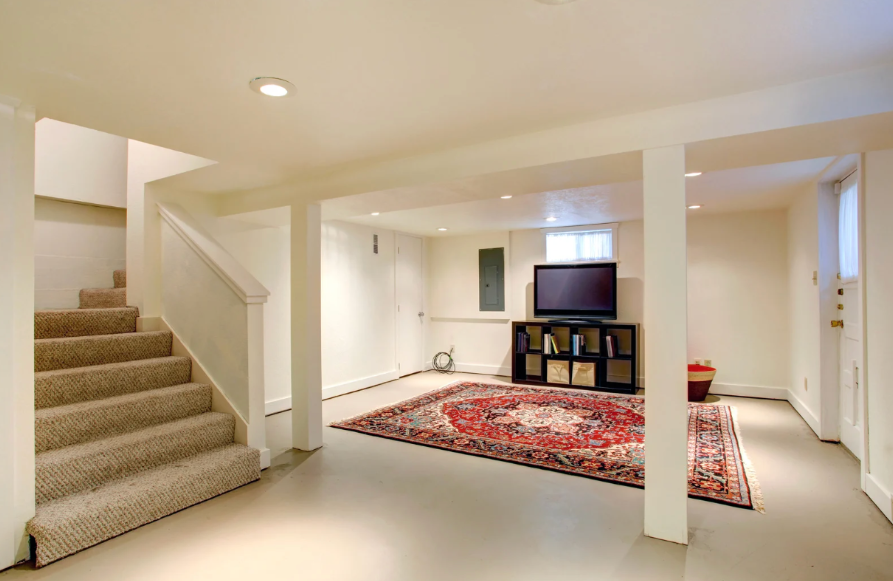
Do you have an unfinished basement that’s just collecting dust and old boxes? You’re sitting on untapped potential! A finished basement can add valuable living space and increase your home’s value.
But where do you start? How do you turn that cold, dark space into a warm, inviting part of your home?
This guide will walk you through everything you need to know about planning a basement renovation. We’ll cover costs, design ideas, common problems, and how to make smart choices along the way.
The Value of Basement Finishing: Is It Worth It?
Before diving into a big project, you probably want to know if it’s a good investment. The numbers say yes!
According to Remodeling Magazine’s Cost vs. Value Report, a basement remodel has an average return on investment (ROI) of 70%. This means if you spend $10,000 on your basement, you could add about $7,000 to your home’s value.
Forbes Article also discusses how strategic renovations can boost a property’s appraisal. It suggests focusing on areas that buyers care about, such as communal spaces like a finished basement, as these can add value to a home.
But the benefits go beyond money. A finished basement gives you:
- Extra living space (up to 1,000 square feet in many homes)
- More functional room for your family’s needs
- Better use of space you’re already paying to heat and cool
- Increased home enjoyment and functionality
The National Association of Home Builders reports that a finished basement ranks among the top five features homebuyers look for. This makes your home more attractive if you ever decide to sell.
First Steps: Assessing Your Basement’s Potential
Not every basement is the same. Before planning your dream space, you need to know what you’re working with.
Check for Moisture Issues
Water problems must be fixed before anything else. Look for:
- Damp spots on walls or floors
- White powder on concrete (efflorescence)
- Musty smells
- Visible mold or mildew
- Water stains or damage to items stored there
If you find moisture problems, fix them first! According to the American Society of Home Inspectors, over 60% of basements experience some form of water intrusion. Addressing this early saves thousands in potential damage later.
Measure Your Space
Know exactly how much space you have to work with:
- Total square footage
- Ceiling height (building codes usually require at least 7 feet)
- Location of support columns, stairs, and utilities
- Window sizes and locations
Take photos of everything. These will help when discussing plans with contractors.
Understand Building Codes
Local building codes will affect your project. Most areas require:
- Proper emergency exits (egress windows)
- Minimum ceiling heights
- Fire safety features
- Permits for electrical, plumbing, and structural work
Call your local building department to learn what permits you’ll need. Working without proper permits can cause big problems when selling your home later.
Creating Your Basement Design Plan
Now for the fun part—deciding what your basement will become!
Decide on the Main Purpose
What does your family need most? Popular basement uses include:
- Family room or entertainment space
- Home office or workspace
- Extra bedroom(s) and bathroom
- Kids’ playroom
- Home gym
- Game room
- Home theater
- Bar or entertaining area
- In-law suite or rental apartment
You can combine several functions, but try to focus on your biggest needs first. For instance, for a home gym, you can start with a few key pieces of equipment, like a treadmill or free weights, and build around that. Alternatively, if you’re thinking about something for the little ones, there are tons of fun and practical indoor playroom ideas that can keep kids entertained while also giving them a space to burn off energy.
Think About Traffic Flow
How will people move through space? Consider:
- Where the stairs enter the basement
- Natural pathways between areas
- Access to windows and exits
- Open spaces versus private rooms
Good flow makes the space feel larger and more comfortable.
Consider Natural Light
Basements often lack windows. To fight the “dungeon feel”:
- Maximize light around existing windows
- Consider adding larger egress windows where possible
- Plan artificial lighting carefully (more on this later)
- Use light colors and reflective surfaces
Lighting experts from the American Lighting Association recommend layering at least three types of lighting in basement spaces to create warmth and depth.
Draw Up a Floor Plan
You don’t need to be an architect. A simple drawing showing:
- Walls and rooms
- Doors and windows
- Furniture placement
- Electrical outlets and fixtures
- Heating and cooling vents
This visual guide will help you communicate your ideas and catch potential problems early.
Budgeting for Your Basement Project
Basement renovations can vary greatly in cost. Let’s break down where your money will go.
Average Costs to Expect
Nationwide, a basement finishing project typically costs between $25-50 per square foot. For a 1,000 square foot basement, that’s $25,000-$50,000 total.
However, costs depend on many factors:
- Your location
- Level of finishes (basic vs. luxury)
- Complexity of the design
- Amount of specialized work (plumbing, electrical)
- Whether you do some work yourself
Where the Money Goes
Understanding cost breakdowns helps you budget wisely:
- Framing and drywall: 15-20%
- Flooring: 10-15%
- Electrical: 10-15%
- Plumbing: 10-15% (more if adding a bathroom)
- HVAC: 5-10%
- Ceiling: 5-10%
- Doors and trim: 5-7%
- Paint and finishing: 5-7%
- Lighting fixtures: 3-5%
- Permits and inspections: 1-3%
- Labor costs: 30-40% of total budget
Setting Priorities
Most people can’t do everything at once. Decide what’s most important for your needs and budget accordingly.
If funds are tight, consider:
- Finishing part of the basement now and expanding later
- Using more affordable materials in some areas
- Doing some prep work yourself
- Creating a phased plan over several years
Remember to always include a 10-15% buffer in your budget for unexpected issues. Basements often hide surprises behind walls and under floors!
Hiring the Right Professionals
While some homeowners tackle parts of basement finishing themselves, most need professional help for at least some aspects.
Do You Need a General Contractor?
For full basement renovations, Fort Collins basement finishing professionals can manage the entire project, including hiring and scheduling all subcontractors. This saves you time and stress, though it adds to the overall cost.
A general contractor is especially valuable if your project includes:
- Multiple rooms or complex layouts
- New bathroom or kitchen areas
- Moving support walls or posts
- Major electrical or plumbing work
- Tight timeline requirements
Finding Quality Professionals
To find trustworthy contractors:
- Ask friends and neighbors for recommendations
- Check online reviews and ratings
- Verify licenses and insurance
- Look at photos of previous basement projects
- Ask for references from past clients
- Get written estimates from at least three contractors
Red Flags to Watch For
Be cautious of contractors who:
- Want large deposits upfront (more than 10-30%)
- Can’t provide proof of insurance
- Pressure you to decide quickly
- Have no online presence or reviews
- Offer quotes much lower than others (may cut corners)
- Won’t provide written contracts
Taking time to find the right professionals pays off in better quality work and fewer headaches.
Major Considerations for Basement Projects
Basements have unique challenges that other rooms don’t. Here’s what to plan for:
Waterproofing and Moisture Control
Even if your basement seems dry, proper moisture barriers are essential. Options include:
- Exterior waterproofing (most effective but expensive)
- Interior waterproofing systems
- Vapor barriers behind walls
- Dehumidifiers for ongoing humidity control
The U.S. Department of Housing and Urban Development reports that proper moisture control is the single most important factor in successful basement conversions.
Ceiling Solutions
Basement ceilings are often crowded with pipes, ducts, and wires. Your options include:
- Traditional drywall ceiling (requires boxing around obstacles)
- Drop ceiling (provides easy access to utilities)
- Painted exposed ceiling (industrial look that maximizes height)
- Partial treatments (combine approaches for different areas)
Flooring Choices
Not all flooring works well in basements. Consider:
- Luxury vinyl plank (waterproof and warm)
- Engineered wood (more moisture-resistant than solid hardwood)
- Ceramic tile (waterproof but cold)
- Carpet with waterproof padding (warm but can trap moisture)
- Epoxy coatings (durable for gym areas)
Avoid solid hardwood, which can warp with basement moisture.
Heating and Cooling
Basements need special attention to stay comfortable:
- Extended ductwork from existing HVAC system
- Separate heating solutions like electric baseboard heaters
- Ductless mini-split systems
- Heated floors for extra warmth
Cold air falls, so basements are naturally cooler than upper floors. Plan accordingly to keep the space comfortable.
Lighting for Warmth and Brightness
Good lighting transforms a basement from gloomy to inviting:
- Recessed lighting for general brightness
- Wall sconces for ambient light
- Task lighting for work or reading areas
- Accent lighting to highlight features
- Light-colored walls and ceilings to reflect light
Lighting designers recommend 10-20 lumens per square foot in basement spaces—much more than upper floors typically need.
Avoiding Common Basement Renovation Mistakes
Learn from others’ errors to make your project more successful.
Skipping the Moisture Test
Always test for moisture before starting. Place 2’x2′ plastic sheets in several locations, tape the edges down, and check after 24-48 hours. Condensation under the plastic means you have moisture issues to address.
Ignoring Insulation
Proper insulation makes a huge difference in comfort and energy bills:
- Insulate exterior walls (R-13 minimum)
- Consider insulating interior walls for sound control
- Don’t forget rim joists around the perimeter
- Use special basement-rated insulation products
The U.S. Department of Energy estimates that proper basement insulation can save 10-30% on heating costs.
Overlooking Soundproofing
Basements can become noisy, and sound travels upward. Consider:
- Insulating ceiling joists
- Using acoustic panels
- Installing solid-core doors
- Adding mass to walls with double drywall or soundproofing materials
These steps keep basement noise from disturbing the rest of the house.
Forgetting About Storage
Even after finishing, you’ll still need storage space. Plan for:
- Closets in finished areas
- Storage rooms for holiday decorations, tools, etc.
- Built-in cabinets and shelving
- Under-stair storage solutions
Not Planning for the Future
Think about how your needs might change:
- Run extra electrical circuits even if not needed now
- Install plumbing rough-ins for future bathroom or wet bar
- Consider access points for future technology needs
- Use modular designs that can adapt over time
The Financial Side of Basement Renovations
Beyond the initial costs, consider the full financial picture.
Home Equity Options
Many homeowners use equity to fund basement projects:
- Home equity loans (fixed amount, fixed rate)
- Home equity lines of credit (HELOC – flexible borrowing)
- Cash-out refinancing (if interest rates are favorable)
Talk to a financial advisor about which option best fits your situation.
Insurance Considerations
After finishing your basement:
- Update your homeowner’s insurance to cover the increased value
- Consider additional coverage for high-value items
- Ask about special riders for home offices or rental units
- Take photos and keep records of everything for potential claims
Tax Implications
Some basement improvements have tax benefits:
- Home office spaces may qualify for tax deductions
- Energy-efficient upgrades might earn tax credits
- Increased property value may affect property taxes
- Rental units create income but also tax considerations
Consult a tax professional about your specific situation.
Basement Finishing Timeline: What to Expect
A typical full basement renovation takes 4-8 weeks, depending on size and complexity. Here’s a general timeline:
- Planning and permits: 2-4 weeks
- Framing: 3-5 days
- Rough electrical and plumbing: 3-5 days
- Inspections: 1-2 days (may be longer waiting for inspectors)
- Insulation: 1-2 days
- Drywall: 4-7 days (including multiple rounds of mudding and sanding)
- Painting: 2-3 days
- Flooring: 2-4 days
- Trim and doors: 2-3 days
- Fixtures and finishing touches: 2-3 days
- Final inspections: 1-2 days
- Cleanup: 1 day
Build extra time into your schedule for delays, which are common in renovation projects.
Conclusion: Your Basement Transformation Journey
Transforming your basement from storage to sanctuary takes planning, patience, and resources. But the reward is substantial—more living space, increased home value, and better use of your existing property.
Remember these key points as you start your basement finishing journey:
- Fix any water or moisture problems first
- Create a clear plan before starting
- Budget realistically, including a contingency fund
- Hire qualified professionals for complex work
- Follow building codes and get proper permits
- Choose materials designed for basement environments
- Think about long-term needs, not just current wants
By taking a thoughtful approach to your basement renovation, you’ll create a space that serves your family well for years to come. What used to be “just storage” can become your favorite part of the house—a true sanctuary that meets your unique needs and reflects your personal style.
Your basement has been waiting to become something special. With proper planning and execution, its transformation will add value, function, and enjoyment to your home for decades.



